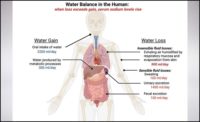Now that I have your attention, let’s talk about the pros and cons of inhaled carbon dioxide.
Carbon dioxide (CO2) is generally thought of as a bad thing. Engineers usually monitor indoor CO2 levels as an indicator of appropriate ventilation to manage unpleasant smells such as body odors, but they do not consider it a toxin itself. Public opinion tends be more negative, regarding CO2 as only a waste product or even a toxin, sometimes confusing it with carbon monoxide. In fact, this is far from true! Let’s take a closer look at the role of this maligned little molecule in human (and all mammalian) physiology so that we can strive for ventilation that promotes health without becoming excessive.
One of life’s essential nutrients
CO2, like oxygen, is essential for human life, and blood levels need to be precisely regulated. Metabolically active tissues such as our muscles release CO2, which then rapidly forms carbonic acid (H2CO3) in our bloodstream. Carbonic acid is a critical acid-base modulator that maintains our body pH within a narrow and healthy range. Eventually, excess CO2 is removed from the body via the lungs in exhaled air.
One common misconception is that CO2 and oxygen are antagonistic, so that when the blood level of one rises, the other one is crowded out and correspondently decreases. This is incorrect! A person’s blood may be high in both gases, or low in both gases, because each are transported by different means and each promotes the diffusion of the other. In the 1800s, scientists Bohr and Verigo found that dissolved CO2 in the blood is needed to release the oxygen carried by hemoglobin. Therefore, when carbonic acid levels are even slightly low, oxygen supply to critical tissues in the body such as the brain, heart, kidneys, and muscles is decreased.
Another misunderstanding for many people is the belief that breathing is stimulated by low oxygen levels. Again, this is incorrect. Normally elevated blood CO2 is what triggers our next breath. Many kids over the years have experimented with intentionally hyperventilating before an underwater race. By breathing rapidly, we lower our blood CO2 level and thereby reduce our respiratory drive, allowing us to break our usual breath holding limit. While we might win the underwater race because of reduced air hunger, we risk drowning. Our unnaturally low CO2 causes rapidly diminishing oxygen to be held onto tightly by hemoglobin, making it unavailable to our oxygen-starved brain and greatly increasing our chance of an underwater blackout.
Chronically low levels of CO2 leads to abnormal nerve and muscle excitability, causing the familiar symptoms of hyperventilation such as “pins and needles” and muscle cramps in one’s hands and feet, dizziness, visual disturbances, and anxiety. Insufficient CO2 can also cause more serious muscle contractions that worsen asthma attacks, migraines, high blood pressure, and chest pain.
At what inhaled concentration does CO2 become toxic to humans?
Dalton’s law can be applied to determine the partial pressures of individual gases exchanged between inhaled air in the lungs and the blood stream:
p(air) = p(N2) + p(O2) + p(CO2) + …
At sea level air pressure (760 mm Hg), the air consists of 78% nitrogen, 21% oxygen, and 0.04% CO2 so each of these three molecules exerts the following pressure:
N2: (78/100)*760 = 593 mm Hg
O2: (21/100)*760 = 160 mm Hg
CO2: (0.04/100)*760 = 0.3 mm Hg
The partial pressure of the CO2 in our blood generated by metabolic processes is approximately 45 mm Hg, or 6%, which equals 60,000 ppm. For this CO2 to cross from the blood to the lungs, the inhaled air simply needs to have a downhill partial pressure gradient. Therefore, theoretically, the partial pressure of CO2 in the air that we breathe just needs to be less than 60,000 ppm! Since this is the lethal level of CO2, conventional wisdom tells us to give ourselves some leeway with indoor ventilation standards. Exactly how much lower is argued, but at least we can relate our ppm goal to human physiology rather than to inherited levels based on body odors! ES




